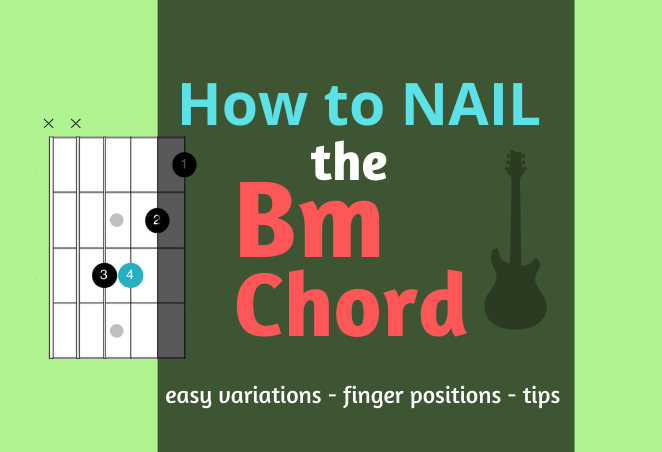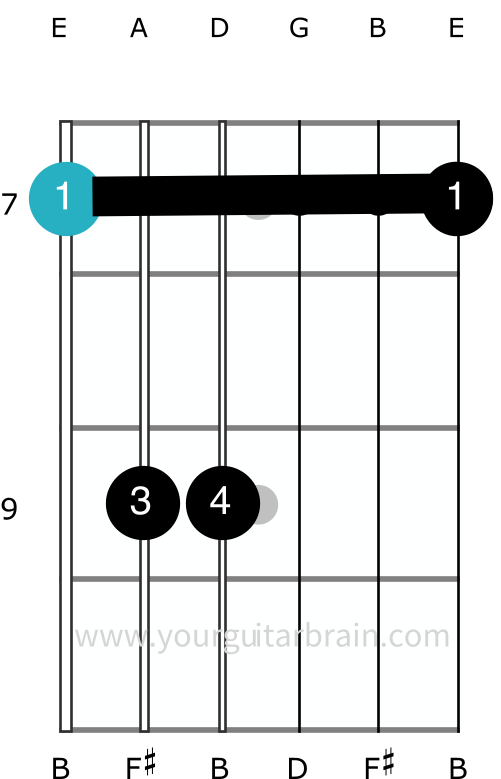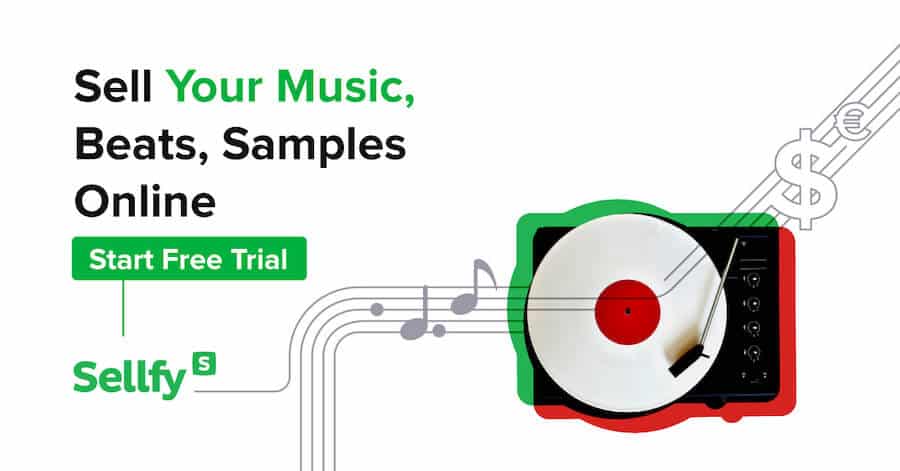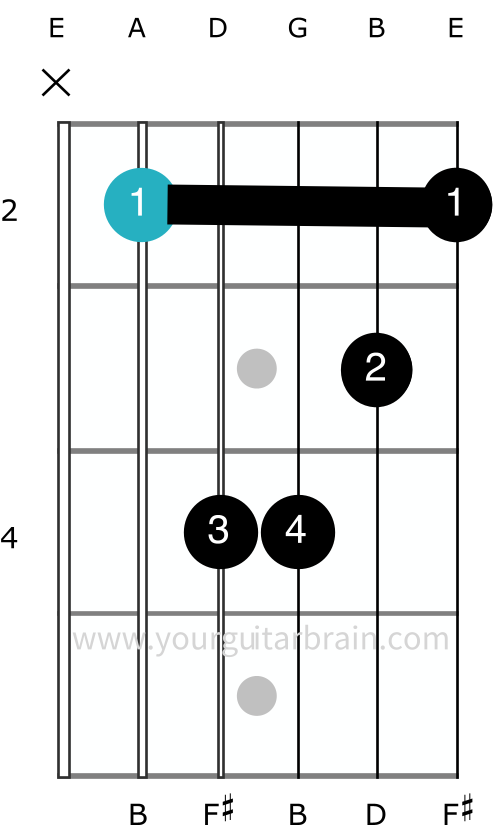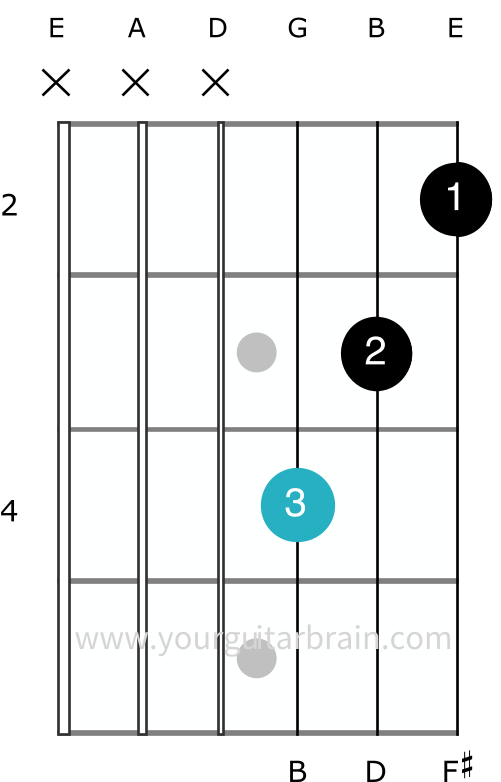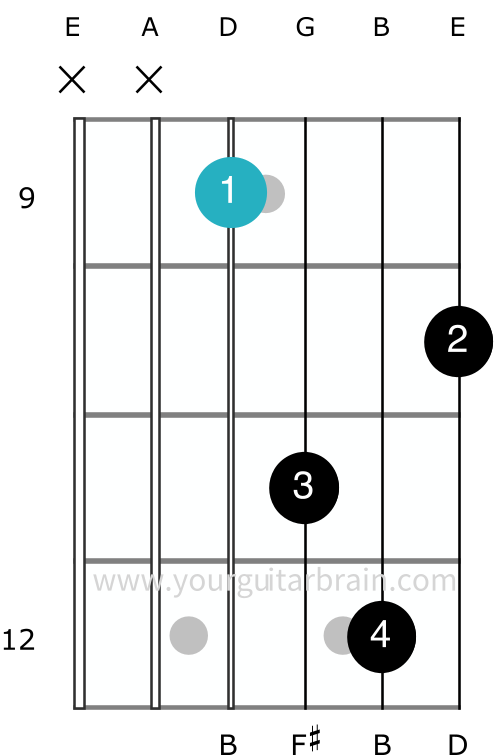How to play the B minor guitar chord the PROPER way & the easy beginner-friendly way. We have chord diagrams that show fingerings, fret numbers and more!
B minor; this cheeky chappy of a guitar chord seems to pop up frequently in songs you want to learn.
Seen as you’ve found your way here (hi!), you’re either a beginner guitar player who’s never come across the Bm chord, or you’ve tried playing the full Bm barre chord shape, and you find it annoyingly awkward.
Whichever box you tick, I have some good news: there are easier ways to play the Bm chord I call stepping stone shapes.
Stepping stone shapes are simplified chord shapes that are easier to learn than barre chords. As a result, they help you build up the finger strength and muscle memory needed to boss the barre eventually.
Let’s start by looking at the four most common ways you’ll see a B minor chord written out to banish any confusion you may have lurking.
B minor Chord Notations
B Minor | Bm | B min | B Minor triad
B minor Chord Theory Facts x 5
- The B minor chord contains the notes: B – D – F#. These notes repeat all over the guitar fretboard (below the 12th fret, there are 7 of each note alone!) We can, therefore, play Bm using a variety of different shapes and voicings.
- The B minor chord is made up of notes taken from the B minor scale. Notably, the 1st (root), flat third (b3) and 5th (perfect fifth).
- The B minor chord formula is: 1 – b3 – 5.
- If we describe a song as being “in the key of B minor”, the first chord (aka the tonic) in the key signature is Bm.
- B minor is one of those must-know chords because it pops up in a fair few of the keys your favourite songs are written in: G Major, D Major, and A Major, for instance.
Good to Know
The chord diagrams below show the best fingerings in the finger position circles. The chord notes are shown below the boxes with the B root highlighted in blue.
Shape 1 – The Proper Bm Chord: The “E Shape”
First up, we have the full Bm barre chord shape.
We call this B minor chord variation the “E shape” because we base the shape around an open E minor chord form (‘form’ is just another way of saying ‘shape’):
B Minor Barre Chord – “E shape”
The B root note is on the 7th fret of the low E (6th) string. Like all minor chords, songwriters use the Bm chord to evoke feelings from sadness to nostalgia to heartbreak.
Here are the correct finger positions:
- First (index) finger – 7th fret of the low E (6th) string and barre across all six strings (6-1)
- Third (ring) finger – 9th fret of the A (5th) string
- Pinky (fourth) finger – 9th fret of the D (4th) string
Pro Tip
This chord shape can be difficult to play cleanly, but you can improve it by using your unused middle (2nd) finger to apply extra pressure on top of your barring index finger.
It is crucial to position your thumb correctly on the back of the guitar neck, under fret 8, when fretting this chord shape.
Don’t be disheartened if you feel you’re fighting a losing battle with this shape; you’re not. You’ll get it eventually once you’ve built up your finger strength and muscle memory.
Shape 2 – The Proper Bm Chord: The “A Shape”
Here’s the most widely used Bm chord shape by guitarists. It’s based on an open A minor chord shape per the CAGED System I talk about in my book for beginner guitarists called Easy Peasy Guitar Music Theory.
B Minor Barre Chord – “A shape”
Here are the finger positions:
- First (index) finger – 2nd fret of the A (5th) string & barre across all five strings (5-1)
- Second (middle) finger – 3rd fret of the B (2nd) string
- Third (ring) finger – 4th fret of the D (4th) string
- Pinky (fourth) finger – 4th fret of the G (3rd) string
Pro Tip
This chord involves barring your index finger across five strings, but make sure you don't press down on the low E string.
The B root note is on the 2nd fret of the A string, so your finger should sit below the 6th string. This is also a handy technique to help you mute string 6 with your fingertip.
Check out the practice tips coming up near the end of the post; they’ll help you if you’re having trouble paying this shape cleanly.
Shape 3 – Easier Bm Chord Variation (4-fingers)
This simpler Bm chord is our first stepping-stone shape. Bear in mind, broken down chords should never be a long-term substitute for the full shapes, but they’re brilliant for building up your finger strength and confidence.
Also, guitarists used these chord voicings in their own right to add interest and flavour to their playing.
If you have a look, this is a variation on the full-barred A Shape. We’re just sending the barre packing and placing our index finger on the 2nd fret of the 1st string. Have a look:
Easier 4-Note Bm Chord (With No Bar)
We call this chord an inversion since the 5th note (F#) is in the bass position rather than the B root.
It still sounds quite rich, despite losing the bottom end you get from the 5th string B note included in the previous barre chord shape.
Finger placements:
- First (index) finger – 2nd fret of the E (1st) string
- Second (middle) finger – 3rd fret of the B (2nd) string
- Third (ring) finger – 4th fret of the D (4th) string
- Pinky (fourth) – 4th fret of the G (3rd) string
Limited-Time Offer! Save 15% on Essential Guitar Chord Digital Poster
Struggle to remember chord shapes? No more! Start learning to play the chords in your favourite songs fast without waiting for shipping ⇩
- Major (C, A, G, E, D, B, F)
- Minor (Cm, Am, Gm, Em, Dm, Bm, Fm)
- Seventh (C7, A7, G7, E7, D7, B7, F7)
- Major seventh (CMaj7, AMaj7, GMaj7, EMaj7, DMaj7, BMaj7, FMaj7)
- Minor seventh (Cm7, Am7, Gm7, Em7, Dm7, Bm7, Fm7)
- Easy open chords + full barre chords
- CAGED guitar chords
Shape 4 – Easy Bm Chord Variation (3-fingers)
This next Bm chord variation is the simplest of the lot. It’s also a valuable shape to know even when you can play the full B barre chord shapes.
We describe this as a triad because it contains three notes. The diagram below shows this shape played on the top three strings (E, B and G).
You can also include the open D (4th) string; bonus points if you know why this is (answer below).
Easy 3-Note B Chord Variation (With No Bar)
Did you know the answer?
It’s because the Bm chord contains the notes B, D and F#; as a result, it won’t make a difference to the quality (type) of the chord if you include the open D string.
It’ll change the voicing. In other words, the B root note will no longer be in the bass position, but the chord will still be B minor, just with an extra D note.
Here are the fingerings:
- First (index) finger – 2nd fret of the E (1st) string
- Second (middle) finger – 3rd fret of the B (2nd) string
- Third (ring) – 4th fret of the G (3rd) string
Shape 5 – B Chord Wildcard: “D-Shape”
If you’re looking to spice up your playing and try something unique, consider using this method to play a B minor chord:
Bm Chord – “D Shape”
This B minor shape is a bit different from the usual barre chords – it’s actually based on the open D minor shape.
Don’t worry if it’s difficult at first. With practice, you’ll improve.
Finger placements:
- First (index) finger – 9th fret of the D (4th) string
- Second (middle) finger – 10th fret of the top E (1st) string
- Third (ring) finger – 11th fret of the top G (3rd) string
- Pinky (fourth) – 12th fret of the B (2nd) string
3 Tips to Help You Master the Bm Chord
The following tips and tricks will help you improve how the Bm sounds on your guitar. The great thing is you can also apply these tips to all the chords you are learning.
1. Thumb position
If you find the Bm barre chord shapes tricky to play, my first tip is to correct your fretting hand thumb position.
The rule of thumb (terrible pun intended) is you should drop your thumb down to the middle of the back of the neck, mirroring where your 2nd finger is on the fretboard.
Taking the E shape Bm chord as an example, position your thumb underneath fret 3.
The closer your thumb is to the fretboard, the easier it is to stretch your fingers and play the chord cleanly.
2. Curve it
If you know your chords aren’t up to scratch, the thought of playing your guitar in front of others can make you feel nervous.
Your confidence will soar once you know your chords sound crystal clear.
One tip to get the B minor clean is to press your barring index finger down as firmly as possible so it has no curve.
When playing the Bm barre chord, it’s common for the B and top E strings to become muted. This is often caused by a curved first finger.
It’s important to adjust the angle of your first finger to find the right spot and prevent muting.
3. Try these chord changes
You can find the Bm chord in the following three common chord progressions. Start by playing one strum per shape and gradually add a strumming pattern once you have mastered them.
1) Key: G Major I – vi – iii – V | G – Em – Bm – D
2) Key: B minor i – VI – III – VII | Bm – G – D – A
2) Key: D MajorI – V – vi – IV | D – A – Bm – G
7 Songs With the B minor Chord
If you’ve just learned the Bm chord or want to polish it up, below are seven popular songs with the B minor chord.
If some of the chord progressions seem like they’re played at a fast tempo, break the songs down.
Practice a few chords at a time. Your chord changes will eventually become clean and quick; it takes dedication and perseverance.
- “Sweet Caroline” by Neil Diamond
- “Hotel California” by The Eagles
- “Just The Way You Are” by Bruno Mars
- “While My Guitar Gently Weeps” by The Beatles
- “Sunday Bloody Sunday” by U2
- “Fake Plastic Trees” by Radiohead
- “Fallin'” by Alicia Keys
Take it slowly and have fun. You’ll get there eventually. Keep the faith and have a blast.
Over and out, amigo.

